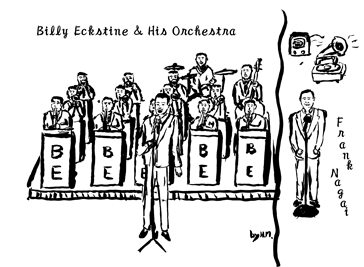

R&B or soul comes after jazz vocal in the years around 1950, but both never can be dicconnected each other. From the late '30s to the middle 40's was the big band era. Billy Eckstine, also known as 'Mr. B', seized the tail of success as a employed singer of the Earl Hines Orchestra from '39 to '43, and then led his own big band from '44 to '47. If you see the photos in some of his CD bests' liner notes, you can find his big band consisted of a pretty large household, that is, trumpets, trombones, tenor and alto and balitone saxes, a piano, a bass, a guitar and drums. However, because of the military draft and travel restrictions in the World War II, the ban of recording and the raise of musicians' pay sought by the musicians' union activity, big bands became hard to stand. Moreover, when star singers left the bands and succeed in singing popular songs, and when musicians who couldn't satisfy themselves of their fixed roles went to the bebop movement, along came the sunset of the big band age. Billy Eckstine also came to sing as a popular singer and accompanied by a sweet orchestra of strings and so on. R&B and soul singers or musicians, nevertheless, had often listened to the big band music when young, so they formed their own bands including some horns even if less members, attired and behave themselves in a sophisticated manner, and covered songs of the big band age. I guess it's because they were simply impressed by those songs, though it's also because they wanted to crossover, in other words, to be sold by whites. I have just recently begun to listen to Billy Eckstine and, to my surprise, I have unexpectedly found he had built the bridge over those ages.
Billy Eckstine is a standard balladeer with a sweet low-balitone and a magnificently symmetrical vibrato, which is a natural one caused when he utters a word; it is different from 'Kobushi (Fist?)', a kind of moving-tone vibrato common in Japan. I think Frank Nagai, a great Japanese crooner who came to the fore since 1950s, should have been influenced by American balladeers including Billy Eckstine but he might sing in a 'Kobushi' vibrato. (I wrote as mentioned above because I recollect the melody of Frank Nagai's gem in his later years Omae-ni (For You) (this tune is also found on his "Best"). Kobushi vibrato appeals to our sentiments with, in the aesthetic point of view, its marginal way of tuning high from the absolute tones, and I think this is one of the characteristics in Kobushi. While 'Japanese Mr. B' Shigeo Oida and others who had learnt jazz from the U.S. occupation forces' bases after the World War II and kept avoiding the popular music scene in Japan and doing jazz for their life, Frank Nagai, who had been such one and joined in the popular side, still have many tunes with his beautiful vibratos.)
The CD "The Legendary Big Band" compiled DeLuxe and National recordings of Eckstine's own big band, which sounds pretty gorgeous as well as his vocal. I am so astonished when I happened to find jazz giants like Dizzy Gillespie, Miles Davis or Art Blakey in the band and Sarah Vaughan as a band singer. On "Everything I Have Is Yours" , the MGM years when he went solo and had hits, you may sit down and listen to his splendid ballads with orchestras consisted mainly of strings. These are so embarrassingly authentic ballad sweets, so I think there are few except Eckstine who can sing gravely the songs like Everything I Have Is Yours or I Apologize enough to make an audience enchanted. Prisoner of Love of National and Bewildered of MGM are covered by James Brown. Brown, a founder of funk, should so admire Eckstine that he led his own about-ten-pieces band, JB's. Fools Rush In (Where Angels Fear to Tread) of MGM is also covered by Brook Benton. For balitone singers like him Eckstine can be said to be exactly their teacher. 1960's live album "No Cover, No Minimum" is incredible. He sings popular sides like Lloyd Price's Lady Luck. His voice is lustrous and stable and he plays a trumpet. Those scenes of the stage and the audience's atmosphere are near to come in sight. Especially, You'll Never Walk Alone, the tune from the musical "Carousel" which has been sung among many black singers beginning with Roy Hamilton, is magestic and inspiring. Eckstine had recordings at Motown or Stax through 60's and 70's. He was like a living dictionary of jazz, R&B or soul. I want to listen to tunes of those years.
After writing above, I have got his "The Motown Years" and his Stax album "Stormy/Feel the Warm" in my hands. At Motown he was backed mainly by orchestras which took care of his career, seldomly with the Funk Brothers' pop treatments. His mature and wonderful delivery in The Prime of My Life and other tunes takes me by surprise in a good sense. He also read other Motown artists like Stevie Wonder or the Four Tops easily. At Stax he had moody arrangements in the Isaac Hayes production or combo-style ones featuring many acoustic guitar works in his own production, however, Eckstine's voice is past his best and reserved. During the era when segregation was done in public and black singers were desired to sing funny novelties and blues, Billy Eckstine had sung ballads which appealed to white women, and had invited those who thought it unpleasant. Moreover, his converting from jazz to pops had come in for criticisms from jazz-purists. However, you can find Billy Eckstine having taken some respects from the later R&B or soul people if you listen to his Motown or Stax sides. (2004/11/04)(2006/04/01)